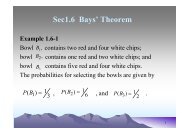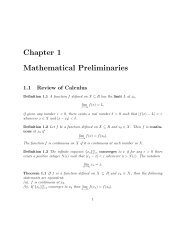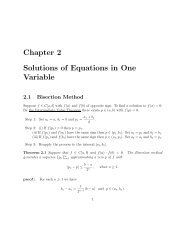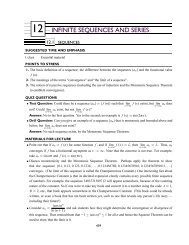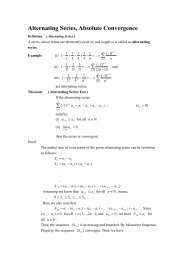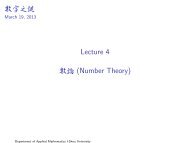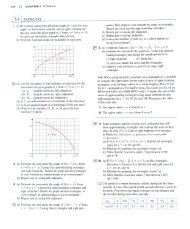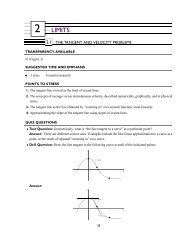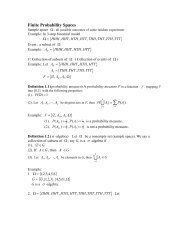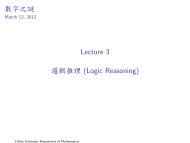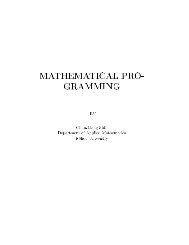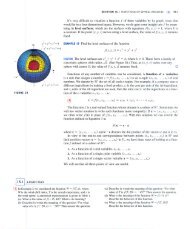[ill x = j .JY (y - 3),
[ill x = j .JY (y - 3),
[ill x = j .JY (y - 3),
Create successful ePaper yourself
Turn your PDF publications into a flip-book with our unique Google optimized e-Paper software.
t e(t) t e(t)<br />
0 0 6 6.1<br />
I 0.4 7 4.0<br />
2 2.8 8 2.3<br />
3 6.5 9 1.1<br />
4 9.8 10 0<br />
5 8.9<br />
-EI EXERCISES<br />
I. The marginal cost function C'(x) was defined to be the<br />
derivative of the cost function. (See Sections 3.7 and 4.7.)<br />
If the marginal cost of maufacturing x meters of a fabric is<br />
C'(x) = 5 - 0.008x + 0.000009x 2 (measured in dollars per<br />
meter) and the fixed start-up cost is C(O) = $20,000, use the<br />
Net Change Theorem to find the cost of producing the first<br />
2000 units.<br />
2. The marginal revenue from the sale of x units of a product<br />
is 12 - 0.0004x. If the revenue from the sale of the first<br />
1000 units is $12,400, find the revenue from the sale of the<br />
first 5000 units.<br />
[II The marginal cost of producing x units of a certain product<br />
is 74 + 1.lx - 0.002x 2 + 0.00004x 3 (in dollars per unit).<br />
Find the increase in cost if the production level is raised from<br />
1200 units to 1600 units.<br />
where F is the rate of flow that we are trying to determine. Thus the total amount of dye<br />
is approximately<br />
n n<br />
L c(t;)F!::.t = F L c(t;) !::.t<br />
A = F s: c(t) dt<br />
A<br />
F=-s:<br />
c(t) dt<br />
where the amount of dye A is known and the integral can be approximated from the concentration<br />
readings.<br />
i!j EXAMPLE 2 A 5-mg bolus of dye is injected into a right atrium. The concentration of<br />
the dye (in m<strong>ill</strong>igrams per liter) is measured in the aorta at one-second intervals as<br />
shown in the chart. Estimate the cardiac output.<br />
SOLUTION Here A = 5, !::.t = 1, and T = 10. We use Simpson's Rule to approximate the<br />
integral of the concentration:<br />
SOlOc(t) dt = Ho + 4(0.4) + 2(2.8) + 4(6.5) + 2(9.8) + 4(8.9)<br />
= 41.87<br />
+ 2(6.1) + 4(4.0) + 2(2.3) + 4(1.1) + 0]<br />
A 5<br />
F = 0 = -- = 0.12 L/s = 7.2 L/min<br />
SOl c(t)dt 41.87<br />
4. The demand function for a certain commodity is p = 20 - 0.05x.<br />
Find the consumer surplus when the sales level is 300. Illustrate<br />
by drawing the demand curve and identifying the consumer<br />
surplus as an area.<br />
W A demand curve is given by p = 450/(x + 8). Find the consumer<br />
surplus when the selling price is $10.<br />
6. The supply function Ps(x) for a commodity gives the relation<br />
between the selling price and the number of units that<br />
manufacturers w<strong>ill</strong> produce at that price. For a higher price,<br />
manufacturers w<strong>ill</strong> produce more units, so ps is an increasing<br />
function of x. Let X be the amount of the commodity currently<br />
produced and let P = Ps(X) be the current price. Some producers<br />
would be w<strong>ill</strong>ing to make and sell the commodity for a<br />
lower selling price and are therefore receiving more than their<br />
minimal price. The excess is called the producer surplus. An



